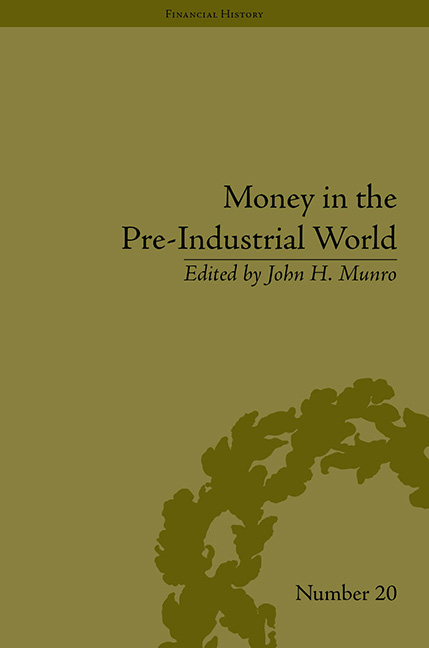Book contents
- Frontmatter
- CONTENTS
- List of Figures and Tables
- List of Contributors
- Introduction
- 1 The Technology and Economics of Coinage Debasements in Medieval and Early Modern Europe: with Special Reference to the Low Countries and England
- 2 From Aurelian to Diocletian: Financing Imperial Recovery by Coinage Debasements and Fiduciary Currencies
- 3 The Making of a Gold Standard: The Ducat and its Offspring, 1284–2001
- 4 Debasement of the Coinage and its Effects on Exchange Rates and the Economy: in England in the 1540s, and in the Burgundian-Habsburg Netherlands in the 1480s
- 5 The Amsterdam Wisselbank's Innovations in the Monetary Sphere: The Role of ‘Bank Money’
- 6 Silver in England 1600–1800: Coinage Outputs and Bullion Exports from the Records of the London Tower Mint and the London Company of Goldsmiths
- 7 The Burdens of Tradition: Debasements, Coinage Circulation and Mercantilist Public Policy Debates in Seventeenth-Century Aragon
- 8 Money or Export Commodity for Asia? American Silver in the Markets of Mexico, Castile and Amsterdam from the Sixteenth to the Eighteenth Century
- 9 Cacao Beans in Colonial México: Small Change in a Global Economy
- 10 Precious Metals, Debasements and Cowrie Shells in the Medieval Indian Monetary Systems, c. 1200–1575
- Notes
- Index
8 - Money or Export Commodity for Asia? American Silver in the Markets of Mexico, Castile and Amsterdam from the Sixteenth to the Eighteenth Century
- Frontmatter
- CONTENTS
- List of Figures and Tables
- List of Contributors
- Introduction
- 1 The Technology and Economics of Coinage Debasements in Medieval and Early Modern Europe: with Special Reference to the Low Countries and England
- 2 From Aurelian to Diocletian: Financing Imperial Recovery by Coinage Debasements and Fiduciary Currencies
- 3 The Making of a Gold Standard: The Ducat and its Offspring, 1284–2001
- 4 Debasement of the Coinage and its Effects on Exchange Rates and the Economy: in England in the 1540s, and in the Burgundian-Habsburg Netherlands in the 1480s
- 5 The Amsterdam Wisselbank's Innovations in the Monetary Sphere: The Role of ‘Bank Money’
- 6 Silver in England 1600–1800: Coinage Outputs and Bullion Exports from the Records of the London Tower Mint and the London Company of Goldsmiths
- 7 The Burdens of Tradition: Debasements, Coinage Circulation and Mercantilist Public Policy Debates in Seventeenth-Century Aragon
- 8 Money or Export Commodity for Asia? American Silver in the Markets of Mexico, Castile and Amsterdam from the Sixteenth to the Eighteenth Century
- 9 Cacao Beans in Colonial México: Small Change in a Global Economy
- 10 Precious Metals, Debasements and Cowrie Shells in the Medieval Indian Monetary Systems, c. 1200–1575
- Notes
- Index
Summary
The monetary regimes of the early modern Atlantic have usually been described as based fundamentally on a bimetallic system of precious metals. Nonetheless, there are some cases that seem to contradict this general assumption. During the whole colonial period, that is, almost three centuries, Mexicans continually complained about chronic shortages of petty coins, notwithstanding the very large outputs of their world-renowned silver production and the Spanish colony's absolute monetary stability. Despite all complaints and petitions to the Spanish crown there was almost no legal copper coinage, not even in the eighteenth century – even though large volumes of copper coinage had been struck within Spain (Castile) itself, since 1599. Thus current token money for everyday payments consisted of different materials, such as lead, playing cards, cocoa (cacao) beans and the like, along with different forms of credit. At the same time that the Mexican colonists were complaining about chronic shortages of small coins, monetary complaints within Spain were directed instead at shortages of gold and silver. Copper coins and fractionary money were, however – as just indicated – always available, sometimes in overwhelming quantities, because of Spain's erratic monetary policies. In the eighteenth century, since copper or vellón coinage no longer presented a problem for the Spanish economy, a debate ensued instead about the possible utility of adopting paper money.
In Amsterdam the monetary situation differed considerably from that found in Spain (Castile) and in Mexico. In the seventeenth century, Amsterdam had emerged as the major financial centre for the Atlantic economies, in part because of the operations of its new Wisselbank (founded 1609), especially in utilizing a money of account ‘bank money’ whose value remained fixed in its fine silver contents (as shown in Herman Van der Wee's chapter in this volume). But in Amsterdam, in contrast to both Mexico and Spain, no chronic complaints about monetary shortages were to be found, despite the concerns of Dutch merchants about obtaining licences to export silver from the Spanish realms (to Amsterdam and then to various foreign regions). Therefore, we may conclude that the monetary functions of the two precious metals in Mexico, Castile and Amsterdam differed from each other and often varied in their forms and goals over the course of the seventeenth and eighteenth centuries.
- Type
- Chapter
- Information
- Money in the Pre-Industrial WorldBullion, Debasements and Coin Substitutes, pp. 129 - 146Publisher: Pickering & ChattoFirst published in: 2014



